导读:杭州G20即将举行,吃喝玩乐必不可少,昨天为大家介绍了杭州的10大美食,今天带大家看一看杭州10大胜景。
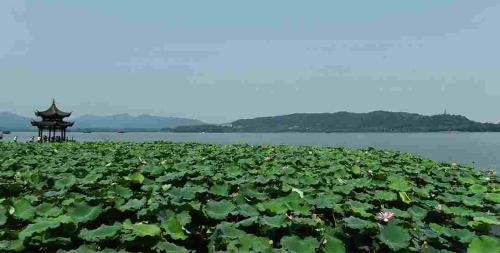
The magnificence of Hangzhou’s scenic beauty is best described by the old Chinese saying: “Up above there is paradise, down here there are Suzhou and Hangzhou.” With the upcoming 2016 G20 summit in Hangzhou almost upon us, let us take a look at the 10 most recommended Hangzhou attractions.
中国有一句老话来形容杭州美景之华丽--“上有天堂,下有苏杭”。在此2016年G20峰会即将在杭州举行之际,让我们一起来看一看杭州10大最值得推荐的美景吧!
The West Lake Cultural Landscape of Hangzhou was recognized by UNESCO as a World Heritage Site in 2011. With a surface area covering 6 square kilometers and 2000 years of history, the West Lake has been visited and admired by countless tourists from around the globe.
杭州西湖文化景观在2011年被联合国教科文组织(UNESCO)认定成为世界遗产。西湖的覆盖面积达到了6平方公里,历史跨度2000多年,全世界无数游客都前来这里参观欣赏。
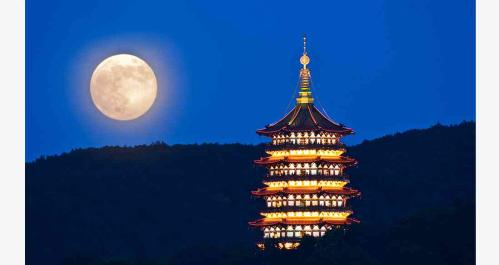
Leifeng Pagoda is located on Nanping Mountain near the West Lake, and was built in 975, during the Five Dynasties and Ten Kingdoms period (907-979). Unfortunately, the original Leifeng Pagoda collapsed in 1924, but in 2002, it was given a second life through government restoration work. Nowadays, the famous scenery of Sunset Glow over Leifeng Pagoda is a favorite spot for tourists.
雷峰塔位于西湖附近的南屏山,始建于公元975年,当时正值五代十国(907-979)时期。不幸的是,雷峰塔旧址在1924年倒塌了,不过在2002年该塔又再一次矗立了起来,政府的修复重建工作让雷峰塔重新焕发了生机。如今,著名的“雷峰夕照”是游客们非常喜爱的景点之一。
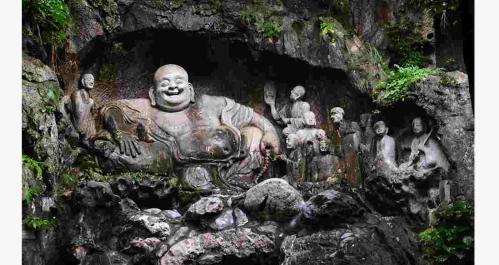
Lingyin Temple, or Temple of the Soul’s Retreat, is the most famous temple in Hangzhou, with a history of around 1,700 years. It is one of the largest and wealthiest Buddhist temples in China, and contains numerous pagodas, Buddhist grottoes and religious rock carvings.
灵隐寺是杭州最为有名的寺庙,其历史跨度约为1700多年。灵隐寺是全中国最大、最富有的佛教寺庙之一,庙内建有大量的宝塔、佛窟和佛教时刻。
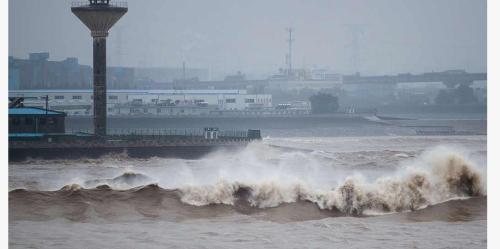
The Qiantang River is the largest river in Zhejiang Province, and is considered to be the major cradle of Yue culture, giving birth to the people of Zhejiang. The Qiantang River also boasts one of the world’s largest tide, causing tourists to gather along the riverbank every year on the 15th to 18th days of the eight lunar month to take in the spectacle.
钱塘江是浙江省境内最大的河流,并被认为是越文化的主要发源地,是浙江人的母亲河。钱塘江还有世界上最大的潮汐流尽管,每年农历八月15到18日期间,都有大量游客聚集在钱塘江畔来观看这一壮阔的奇观。
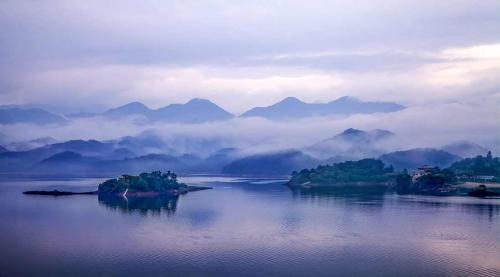
Thousand Islets Lake lies in Chun’an county of Hangzhou City, Zhejiang Province. It is China’s first artificial lake as well as its largest national park. The lake gets its name from the 1,078 islands found within its waters, linking tourist attractions between Zhejiang and Anhui Provinces with a flourishing tourism network.
千岛湖位于浙江杭州淳安县内。千岛湖是中国第一个人工湖,同时也是中国最大的国家公园。由于在该水域内发现有多达1078座岛屿,因此得名“千岛湖”。千岛湖以其繁荣的旅游网络连接了浙江和安徽两省的旅游景点。

Meijiawu Tea Village in Hangzhou is well known for its Longjing tea plantation. Longjing tea, literally translated as Dragon Well tea, was once granted the status of Gong Cha, or imperial tea, for the Emperors of the Qing Dynasty (1644-1911). Meijiawu has a history of over 600 years and is home to 160 tea houses. Here, visitors can learn more about the region’s rich tea culture, as well as try their hands at picking tea leaves under the guidance of the Meijiawu experts.
杭州梅家坞茶村以其龙井茶园而闻名。龙井茶曾经被当做贡茶进献给清朝(1644-1911)皇帝。梅家坞的历史长达600多内,村内由160家茶馆。在这里,游客们可以了解到该地区丰富的茶文化,同时也可以在梅家坞专家的指导下尝试亲手摘茶叶。

The Beijing-Hangzhou Grand Canal is the longest ancient canal in the world, stretching a length of 1794 kilometers. The canal begins in Hangzhou, where tourists can appreciate the beauty of the water town and experience the tranquil lifestyle of Hangzhou residents.
京杭大运河是全世界最长的古代运河,全长1794公里。京杭大运河始于杭州,在这里游客们可以欣赏水乡的美景,同时也可以领略杭州居民们的宁静生活。
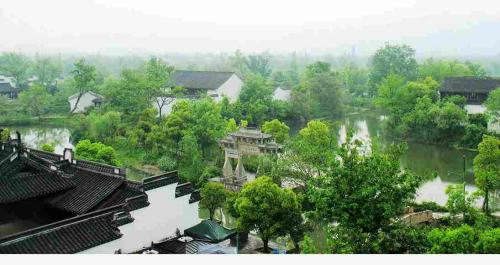
Xixi National Wetland Park is the only national wetland park in China, with river ports, ponds, lakes and wetlands covering 70% of the park’s area. In Xixi National Wetland Park, three causeways (Fu, Lu, and Shou Causeway) and ten sights (Dasheng Nunnery, Water Mirroring Red Persimmons, Dragon Boat Pageant, Egret Trace with the Lotus, Hong’s Villa, Moonlight Mirroring within the Reeds, Rainy Fishing Village, Xixi Plum Villa, Gao’s Villa, and Appreciate Music in Hezhu) are regarded as must-sees.
西溪国家湿地公园是中国唯一的湿地国家公园,公园内河港、池塘、湖泊和湿地的覆盖面积达到了70%。在西溪国家湿地公园,山堤(福、禄、寿)十景(秋芦飞雪、火映柿波、龙舟盛会、莲滩鹭影、洪园余韵、蒹葭泛月、渔村烟雨、曲水寻梅、高庄宸迹、河渚听曲)决不可错过。
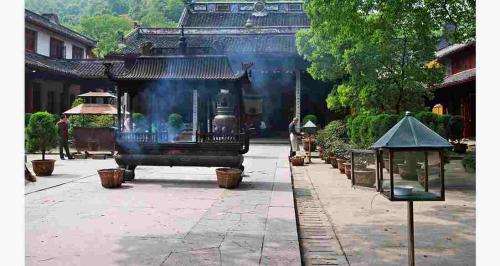
The Three Temples of Tianzhu Hill nearby the West Lake were given the names of Faxi Temple (the upper Tianzhu temple), Fajing Temple (the middle Tianzhu temple), and Fajing Temple (the lower Tianzhu temple) by Emperor Qianlong (1711-99) in the Qing Dynasty (1644-1911). The three temples share a deep Buddhist heritage, helping the region of Hangzhou earn the honorary title “The Buddhist Heaven of Tianzhu.”
西湖附近的“天竺三寺”之名得自于天竺山的三座寺庙,分别是法喜寺(上天竺寺)、法净寺(中天竺寺)和法镜寺(下天竺寺)。三寺之名有清朝乾隆皇帝(1711-1799)命名。天竺三寺共享一个渊源深厚的佛教文化背景,帮助杭州该地区获得了“天竺佛教圣地”的殊荣。
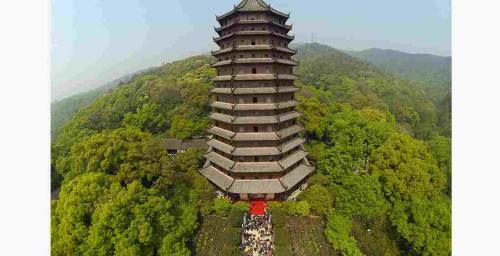
Six Harmonies Pagoda, or Liuhe Pagoda, is a masterpiece of ancient Chinese architecture. It was first built to calm the tides of the Qiantang River in the Northern Song Dynasty (960-1127), drawing its name “Six Harmonies” from Buddhist teachings. Today, it serves as an ideal lookout point over the Qiantang River.
杭州六和塔是中国古代建筑的杰作瑰宝。该塔始建于北宋(960-1127)时期,用来镇压钱塘江大潮,其名“六和”来源于佛教教义。时至今日,六和塔已经成为了一个眺望钱塘江的绝佳地点。